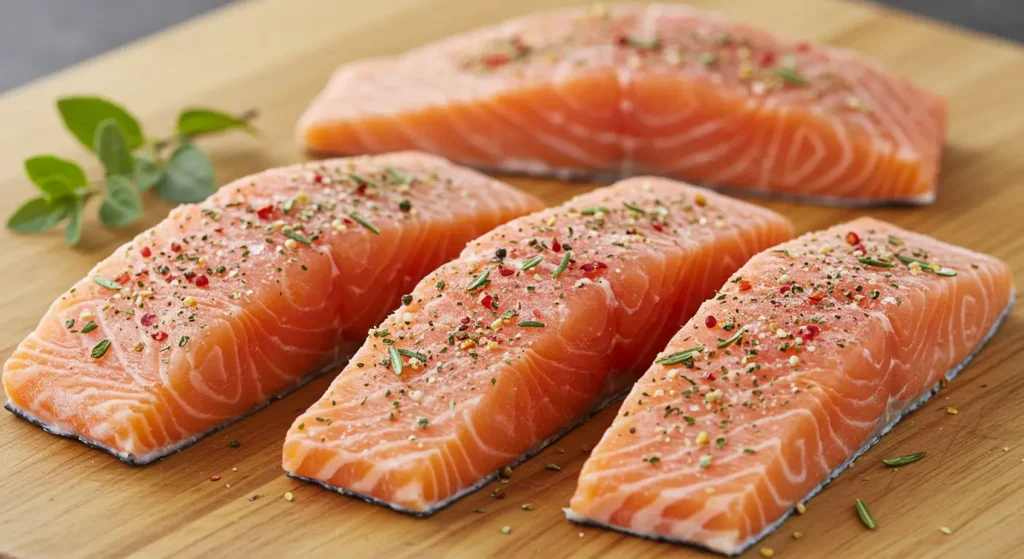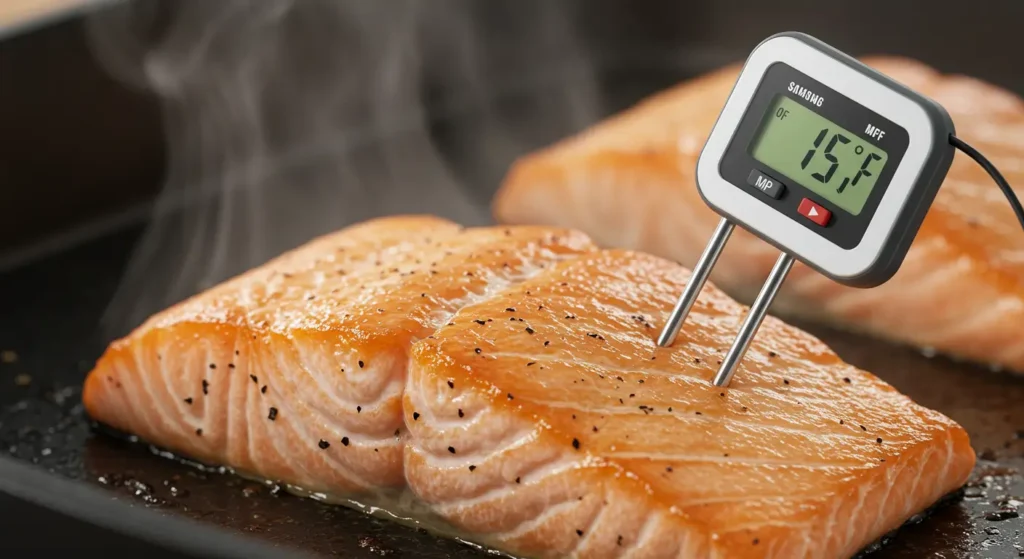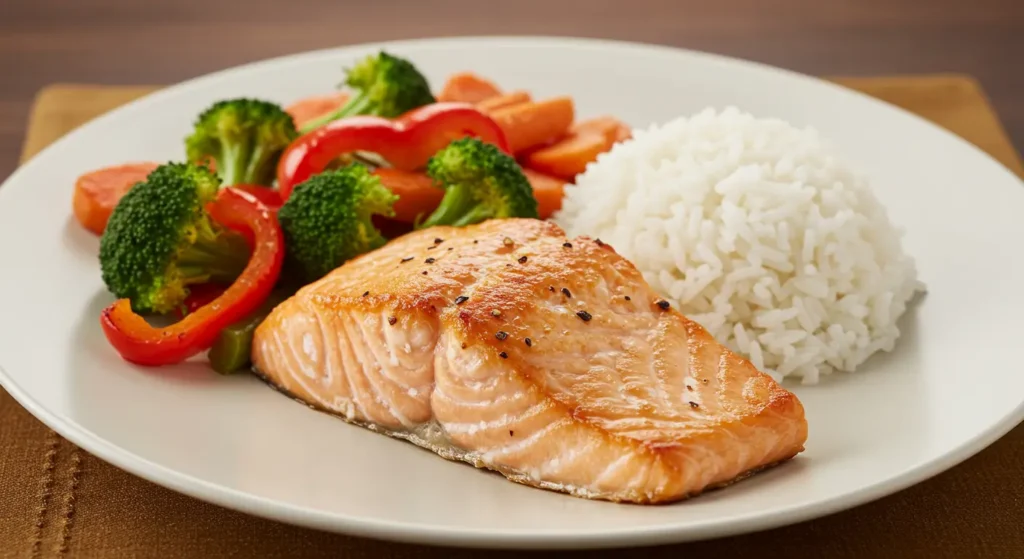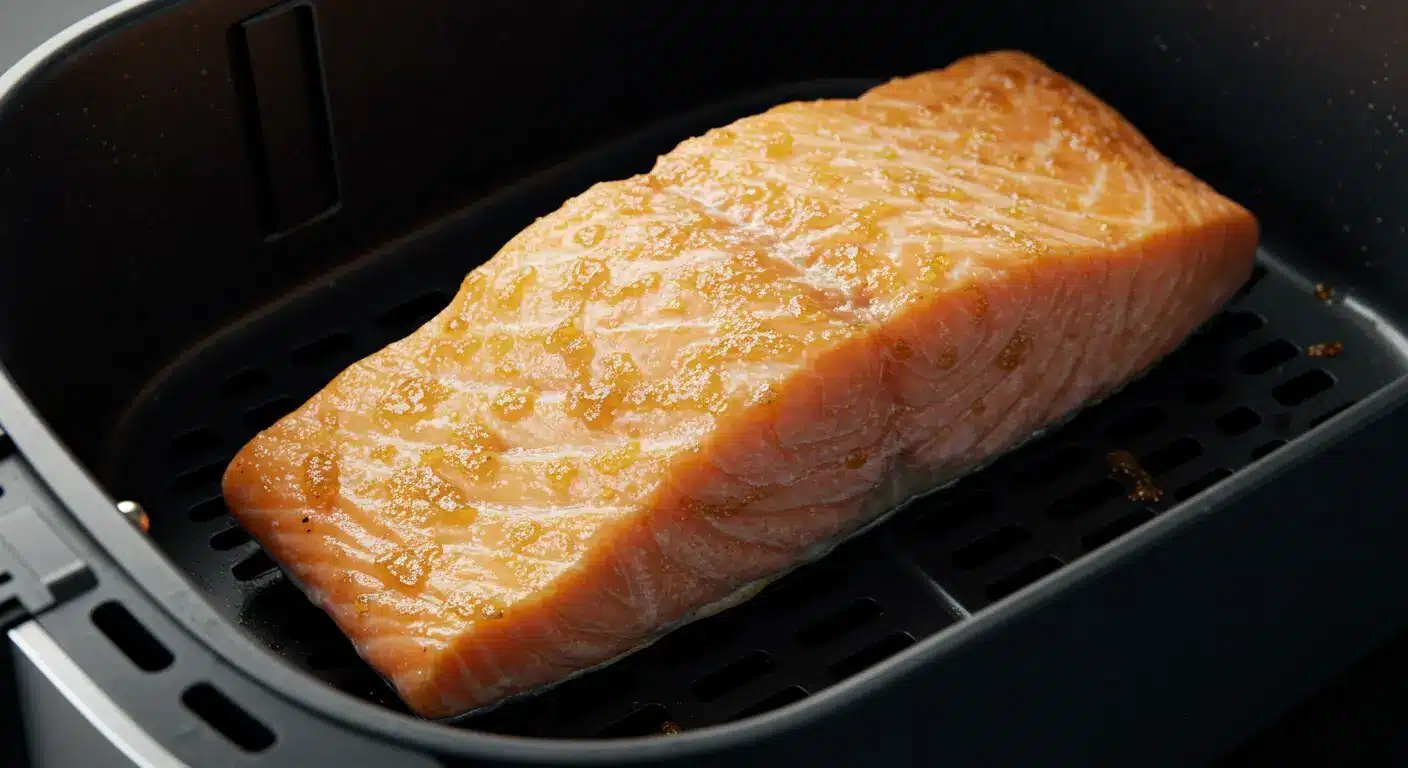Air Fryer Frozen Salmon – The Best No-Thaw Method for Crispy, Juicy Results
Cooking salmon straight from frozen in an air fryer might sound like a shortcut, but it’s actually one of the best ways to get restaurant-quality results at home. Whether you’re tight on time or forgot to defrost your fillet, this method delivers tender, flaky salmon with a crisp exterior every time—no thawing needed. In this guide, we’ll walk through exactly how to make perfect air fryer frozen salmon, covering temperature and timing tips, marinades, seasonings, reheating advice, and the most common mistakes to avoid. Plus, we’ll answer the most searched questions like “Can you put frozen fish straight in the air fryer?” and “Is it better to cook salmon thawed or frozen?”
Looking for inspiration? Try our Air Fryer Frozen Salmon recipe that makes dinner quick and foolproof.
Table of Contents
Why Cook Frozen Salmon in the Air Fryer?
Quick and Healthy Weeknight Option
One of the top reasons to love air fryer frozen salmon is its sheer convenience. Forget waiting hours to thaw or dealing with soggy microwave defrosting. With the air fryer, you go from freezer to dinner plate in under 20 minutes. It’s a go-to solution for busy parents, working professionals, or anyone who wants to eat better without spending all night in the kitchen. The air fryer uses circulating hot air to cook the fish evenly while locking in moisture, making it an ideal method for lean proteins like salmon. Even picky eaters won’t guess it was cooked from frozen.
Plus, there’s minimal cleanup involved. No extra pans, no oven preheating—just your trusty air fryer basket and a piece of frozen salmon.
Benefits Over Traditional Baking or Pan-Frying
While baking frozen salmon in the oven is a tried-and-true method, it takes longer and can sometimes leave you with uneven results. Edges may overcook while the center stays raw. On the other hand, pan-frying requires thawing first and can lead to sticking or oil splatter.
The air fryer solves both issues. It preheats quickly, crisps up the exterior nicely without added oil, and ensures an even cook thanks to its rapid circulation technology. This method is also more energy-efficient than heating your entire oven for a small meal. And for anyone watching calories, the air fryer helps you skip excess fats without sacrificing texture or flavor.
Discover great ideas like our Delicious Teriyaki Salmon that also works perfectly with frozen fillets.
How to Cook Frozen Salmon in an Air Fryer – Step-by-Step Guide

Essential Ingredients and Tools You’ll Need
To get started, you’ll need a few simple ingredients and tools. First, grab frozen salmon fillets—wild-caught or farmed both work fine. Opt for skin-on fillets if you love crispy texture. You don’t need to thaw them, just remove any ice crystals before seasoning.
Next, gather your seasonings. A basic mix of salt, pepper, garlic powder, and paprika works well. You can add a squeeze of lemon or a brush of olive oil for extra flavor. If you want a glaze, honey mustard or teriyaki sauce pairs perfectly with salmon.
As for tools, the star is your air fryer. Any model will work, though basket-style air fryers tend to circulate heat more efficiently. A silicone brush for spreading marinades and a digital thermometer are helpful too.
Check out our guide on Salmon Eggs Benedict if you’re planning to use leftovers creatively the next day.
Step-by-Step Air Fryer Instructions for Frozen Salmon
- Preheat the air fryer to 390°F (199°C) for about 3-5 minutes. This ensures even cooking from the get-go.
- Prep the salmon. Take your frozen fillet out of the packaging and rinse off any ice. Pat it dry with paper towels.
- Season or glaze. Lightly coat the salmon with olive oil, then sprinkle your seasonings. If using a marinade, wait until halfway through cooking to apply it—this prevents burning.
- Place in the basket. Lay the fillet skin-side down in the air fryer basket. Make sure pieces don’t overlap.
- Cook for 7-9 minutes, then flip. Use tongs to carefully turn the salmon over. If you’re glazing, do it now.
- Cook for another 5-6 minutes. Internal temperature should reach 145°F (63°C). The outside should be golden, and the inside flaky and moist.
- Let it rest. Pull the salmon out and let it sit for 2-3 minutes. This helps juices settle for a more flavorful bite.
That’s it—no thaw, no mess, just perfectly cooked salmon in under 15 minutes. For variations like honey garlic flavor, check out Honey Garlic Glazed Salmon for more dinner ideas.
Timing Guide – How Long to Cook Frozen Salmon in an Air Fryer
Cook Times by Thickness and Temperature
Getting the timing right is key to perfectly cooked salmon. One size does not fit all—thickness matters more than weight when air frying frozen fillets. A 1-inch thick salmon fillet generally takes about 12 to 14 minutes at 390°F. Thinner cuts—around ½ inch—cook faster, around 9 to 11 minutes. If you’re dealing with a thicker, 1½-inch fillet, you might need up to 16 minutes total, flipping halfway through.
Always check for doneness with a digital thermometer. The USDA recommends salmon reach 145°F internally, measured in the thickest part of the fish. If you don’t have a thermometer, look for flakes—if it separates easily with a fork and the inside is opaque, it’s ready to eat.
Don’t miss our tips on Delicious Salmon Cakes to use any leftovers you have on hand.
400°F vs 375°F vs 350°F – Which Is Best?
Most home cooks swear by cooking salmon at 390°F or 400°F in the air fryer. This high heat ensures a crisp outer layer without drying the fish. Cooking at 375°F will still get the job done but requires a few extra minutes, and you may miss out on that crispy finish. At 350°F, your salmon might turn out too soft or undercooked in the center unless you extend the cooking time significantly.
Here’s a quick time-temperature table for reference:
| Air Fryer Temp | Thickness | Time (Total) | Flip Halfway? |
|---|---|---|---|
| 390°F | 1 inch | 12-14 min | Yes |
| 400°F | 1 inch | 11-13 min | Yes |
| 375°F | 1 inch | 14-15 min | Yes |
| 350°F | 1 inch | 16-18 min | Yes |
If you’re unsure, start lower and add time as needed. Air fryer models vary, so test once or twice to dial in your perfect settings.
Check out our Salmon Loaf if you’re curious about other cozy salmon options for meal prep.

Best Seasonings and Marinades for Air Fryer Frozen Salmon
Dry Rubs vs Liquid Marinades – What Works Better
Both dry rubs and marinades bring big flavor, but in the air fryer, they behave differently. Dry rubs are ideal because they don’t create extra moisture. A simple blend of paprika, garlic powder, black pepper, and sea salt adds bold taste and a lightly crisped crust. You can even add a pinch of cayenne for a spicy kick.
Liquid marinades work too, but timing is key. Applying them from the start can lead to burnt sugars or soggy skin. Instead, air fry your salmon for about 7 minutes first, then brush on the glaze and finish the remaining cook time. This keeps the flavors bold without the mess.
Want something tangy and sweet? Brush with teriyaki or soy-honey glaze during the final minutes. For something classic, lemon-dill butter or garlic-lemon mix adds a gourmet touch without much effort.
Looking for inspiration? Try this flavorful variation in our Delicious Teriyaki Salmon.
Delicious Flavor Combinations to Try
Here are go-to flavor combos that work great with frozen salmon in the air fryer:
- Lemon Garlic Herb: Olive oil, lemon zest, garlic powder, thyme
- Maple Dijon: Maple syrup, Dijon mustard, black pepper
- Cajun Butter: Melted butter, Cajun seasoning, a dash of smoked paprika
- Asian-Inspired Glaze: Soy sauce, sesame oil, brown sugar, ginger
- Chili Lime: Chili powder, lime juice, cumin, olive oil
Want to keep it simple? Just a little olive oil, lemon juice, and cracked pepper does wonders. You’ll be amazed how flavorful frozen salmon can be with the right combo of seasonings.
Check out Honey Garlic Glazed Salmon for more sweet-savory inspiration that’s perfect for air frying.
Common Questions Answered
Can You Cook Salmon From Frozen in an Air Fryer?
Yes, and it’s one of the easiest and most reliable methods. You don’t need to defrost it first. Just rinse off any ice crystals, pat the salmon dry, season, and pop it in your air fryer. It cooks evenly and comes out moist and flaky, especially when using temperatures around 390°F. The hot circulating air handles frozen fillets like a champ.
How Long to Bake Salmon at 400 From Frozen?
Baking frozen salmon in a traditional oven at 400°F typically takes 25 to 30 minutes depending on thickness. In contrast, using an air fryer can cut that time in half. It’s much faster and keeps the salmon juicier. So if you’re in a rush, skip the oven and go straight to the air fryer.
How Long to Air Fry Frozen Salmon Reddit?
Reddit users generally suggest cooking frozen salmon at 390°F for 12 to 14 minutes, flipping halfway through. This lines up with our own tests. Some even recommend starting at 400°F for a crisper texture. If your fillet is thicker than 1 inch, expect to add 2–3 extra minutes.
Can You Put Frozen Fish Straight in the Air Fryer?
Absolutely. As long as the fillets aren’t stuck together, frozen fish—including salmon—can go right into the air fryer. Just make sure the pieces are separated and not covered in excess frost. Pat them dry if needed. This helps the seasonings stick and ensures even browning.
How Long to Cook Salmon From Frozen?
In the air fryer, 12 to 16 minutes is the sweet spot for most frozen salmon fillets. The total time depends on the thickness of the fish. Always check that the internal temperature reaches 145°F, and look for opaque, flaky flesh.
Is It Better to Air Fry Fish Frozen or Thawed?
Both methods work, but cooking from frozen is more convenient. You don’t lose time waiting for the fish to defrost, and it still turns out delicious. Thawed salmon may cook slightly faster, but it also increases the risk of overcooking. For consistent results, cooking from frozen is often the safer bet—especially for busy weeknights.
Don’t miss our Air Fryer Frozen Salmon recipe walkthrough for perfect results every time.
Pro Tips for Crispy Skin and Juicy Salmon
How to Avoid Drying Out the Salmon in the Air Fryer
Dry salmon is a common fear, but it’s totally avoidable. First, don’t overcook—most air fryer mistakes come from too much time at too high a temp. Stick to 12–14 minutes at 390°F for average-size fillets. Always use a digital thermometer to check the internal temp—145°F is your target. Go higher, and it’ll start drying out fast.
Second, brush the fish with a thin layer of oil or butter before seasoning. This locks in moisture and helps the spices stick. If you’re using a glaze or sauce, apply it after the first half of cooking. That way, the sugars don’t burn but still get a nice caramelized finish.
Lastly, don’t skip the resting time. Once your salmon is done, let it sit for a couple of minutes before cutting in. This lets the juices redistribute and keeps every bite tender.
Techniques for Achieving Perfectly Crisp Skin Every Time
Want crispy skin? Start with skin-on fillets, and place them skin-side down in the basket. This gives the skin direct heat contact, helping it crisp without curling. Avoid flipping if the skin is delicate—it can stick if the air fryer isn’t properly greased.
To boost crispiness, you can lightly salt the skin side and let the salmon sit for a few minutes before cooking. Salt draws out surface moisture, which helps it crisp up. If your air fryer has a grill tray or raised rack, use it. It allows air to circulate under the fillet for more even results.
Avoid overcrowding. Give each piece room so hot air can move around freely. That’s the secret to even crisping.
Need another crispy fix? Don’t miss our Crispy Fried Cod Fish for a golden seafood experience.
Side Dishes That Pair Well With Air Fryer Salmon
Quick Veggies, Grains, and Sauces for Weeknight Meals
A perfectly cooked salmon fillet deserves sides that complement its flavor without stealing the show. Roasted asparagus, steamed broccoli, or air-fried Brussels sprouts make excellent pairings and can even be cooked right alongside your salmon if your fryer has room.
For grains, try garlic butter rice, quinoa, or even lemon couscous. These are fast to prep and soak up any leftover salmon juices or sauce beautifully. If you’re short on time, a simple microwaveable brown rice packet works just fine.
Adding a sauce? A drizzle of lemon-dill yogurt, garlic aioli, or even a spoon of tzatziki turns your salmon dinner into something restaurant-worthy without extra effort.
Looking for inspiration? Try pairing your salmon with sides from our Healthy Shredded Chicken Meal that’s packed with flavor and texture.
Low-Carb, Gluten-Free, and Family-Friendly Pairings
If you’re watching carbs or avoiding gluten, don’t worry—there are still plenty of side options. Think cauliflower mash, zucchini noodles, or sautéed spinach. They’re low on carbs but big on flavor.
For a full family dinner, keep it fun and colorful. Kids love sweet potato fries or mac and cheese with salmon. Add a fruit salad or some apple slices to keep things balanced. It’s all about mixing textures and flavors so dinner never feels boring—even when it’s a freezer-to-table night.
Discover great ideas like these in our Delicious Acorn Squash Recipes for more colorful, satisfying side options.

Storage, Reheating & Leftovers Tips
How to Store and Freeze Cooked Salmon Properly
If you’ve made extra, storing your air fryer salmon the right way keeps it tasting fresh. First, let the salmon cool to room temperature. After that, seal it well with foil, plastic wrap, or an airtight container, and refrigerate for up to three days.
For longer storage, freezing is a great option. Place cooled fillets in a zip-top freezer bag, squeeze out the air, and label the date. Frozen cooked salmon lasts about 2 to 3 months in the freezer. Just know the texture might be a little softer once thawed, so it’s best used in recipes like casseroles or salads.
You can also break up the salmon into smaller chunks before freezing—this makes it easier to reheat only what you need.
Reheating Without Losing Moisture
To keep leftovers juicy, don’t blast them with heat. Instead, reheat salmon in the air fryer at 350°F for about 4-5 minutes. Add a light brush of oil or a splash of broth before reheating to help lock in moisture. Covering it with foil while reheating also prevents it from drying out.
Avoid the microwave if you can—it tends to overcook the edges. If you must, use 50% power and short bursts, checking often.
Leftover salmon works great in wraps, pasta, or even breakfast. Don’t miss our idea-packed Salmon Eggs Benedict to turn leftovers into something exciting.
Mistakes to Avoid When Air Frying Frozen Salmon
Common Blunders That Lead to Rubbery or Dry Fish
One of the most common mistakes is overcooking. It’s easy to assume frozen salmon needs more time, but too much heat dries it out fast. Maintain a temperature of 390°F for best results, and start checking for doneness around 12 minutes, particularly if you’re cooking thinner fillets.
Another slip-up is skipping the drying step. Ice crystals left on the fish can create steam, leading to soggy skin and uneven cooking. Always pat the salmon dry before seasoning.
Don’t overcrowd the basket. If fillets are touching or stacked, the air can’t circulate well. This leads to undercooked centers and overcooked edges.
Also, resist the urge to apply marinades too early. Sugar-based sauces burn quickly. Add them only in the last few minutes for the best flavor without bitter notes.
Air Fryer Settings and Timing Errors to Avoid
Not all air fryers are built the same. One big mistake is not preheating your air fryer. Starting cold means your salmon cooks unevenly. Always preheat for 3–5 minutes.
Another issue is relying solely on time. Thickness varies from fillet to fillet, so use a thermometer when possible. That’s how you avoid guessing and get perfectly cooked salmon every time.
And finally, avoid using too much oil. A light brush is all you need. Over-oiling not only adds unnecessary calories but can also lead to soggy skin.
Don’t miss our full walkthrough on Air Fryer Frozen Salmon to avoid every one of these common missteps.
Conclusion: Air Fryer Frozen Salmon is a Game-Changer
Cooking salmon straight from the freezer doesn’t mean sacrificing flavor or texture. The air fryer makes it easy, fast, and delicious every time. Whether you’re making a weeknight meal or prepping leftovers for the next day, this method delivers crisp skin, tender meat, and minimal cleanup.
Learn more about how to perfect your seafood skills with our Delicious Salmon Cakes and Honey Garlic Glazed Salmon for more ways to enjoy this powerhouse protein.
FAQs
Can you cook salmon from frozen in an air fryer?
Yes, it’s one of the easiest methods. No thawing needed—just season and cook. The air fryer circulates heat so well, your frozen fillet ends up juicy and evenly cooked.
How long to bake salmon at 400 from frozen?
In a conventional oven, expect 25–30 minutes. That’s nearly double the time it takes in an air fryer, where 12–14 minutes usually does the job.
How long to air fry frozen salmon Reddit?
Most Reddit users agree: 390°F for 12 to 14 minutes, flipping once. It’s a quick and tested approach that works for fillets up to 1-inch thick.
Can you put frozen fish straight in the air fryer?
Absolutely. Just pat off any surface frost and season well. There’s no need to thaw it first, and it still turns out flaky.
How long to cook salmon from frozen?
Total cook time depends on thickness. For most 1-inch frozen salmon fillets, aim for 12 to 16 minutes at 390°F, flipping halfway through.
Is it better to air fry fish frozen or thawed?
Both work, but frozen is often more convenient and just as tasty. You skip the defrost and reduce the risk of overcooking.

